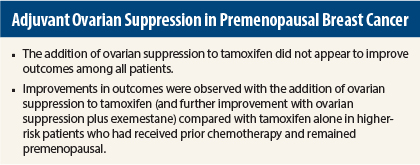In a phase III trial (SOFT) reported in The New England Journal of Medicine, Prudence A. Francis, MD, of Peter MacCallum Cancer Centre, Melbourne, Australia, Meredith M. Regan, ScD, of IBCSG Statistical Centre at Dana-Farber Cancer Institute, Boston, and colleagues found that the addition of ovarian suppression to tamoxifen did not improve disease-free survival among all women with premenopausal hormone receptor–positive breast cancer but appeared to have a beneficial effect in those who had received adjuvant chemotherapy and remained premenopausal.1 Treatment with exemestane plus ovarian suppression vs tamoxifen alone was associated with even greater benefit in this higher-risk group.
Study Details
In the study, 3,066 premenopausal women with breast cancer were randomized to receive 5 years of tamoxifen (n = 1,021), tamoxifen plus ovarian suppression (n = 1,024), or exemestane plus ovarian suppression (n = 1,021) between December 2003 and January 2011. Randomization was stratified by receipt or nonreceipt of adjuvant chemotherapy. Ovarian suppression was achieved by triptorelin (Trelstar depot in the U.S.) treatment, bilateral oophorectomy, or bilateral ovarian irradiation.
Patients had a median age of 43 years, 46.7% of the patients had not received prior chemotherapy and 53.3% had received prior chemotherapy and remained premenopausal, and 34.9% of patients had node-positive disease.
The primary analysis tested the hypothesis that tamoxifen plus ovarian suppression would improve disease-free survival vs tamoxifen alone. The study was originally designed to compare disease-free survival between the three treatment groups with three pairwise comparisons. However, enrolled patients were older and had lower-risk characteristics than anticipated, and the rate of disease-free survival was higher than expected. A protocol amendment to the statistical analysis plan was adopted in 2011; it designated the test of superiority of tamoxifen/ovarian suppression over tamoxifen alone as the primary analysis and the comparison of exemestane/ovarian suppression vs tamoxifen alone as a secondary analysis.
Outcomes in Total Population
After a median follow-up of 67 months, 14.7% of patients had recurrent disease or a second invasive cancer or had died. The rate of disease-free survival at 5 years was 86.6% in the tamoxifen/ovarian suppression group vs 84.7% in the tamoxifen group (hazard ratio [HR] = 0.83, P = .10). On multivariate analysis adjusting for prognostic factors, the HR was 0.78, P = .03. The 5-year rate of disease-free survival with exemestane/ovarian suppression was 89.0% (HR = 0.68, 95% confidence interval [CI] = 0.53–0.86, vs tamoxifen).
The 5-year rate of freedom from breast cancer was 88.4% with tamoxifen/ovarian suppression vs 86.4% with tamoxifen (HR = 0.81, P = 0.09; adjusted HR = 0.75, P = 0.02) and 90.9% with exemestane/ovarian suppression (HR = 0.64, 95% CI = 0.49–0.83). The 5-year rate of freedom from distant tumor recurrence was 91.3% with tamoxifen/ovarian suppression vs 90.7% with tamoxifen (HR = 0.88, 95% CI = 0.66–1.18) and 93.0% with exemestane/ovarian suppression (HR = 0.71, 95% CI = 0.52–0.96, vs tamoxifen). Overall survival at 5 years was 96.7% with tamoxifen/ovarian suppression vs 95.1% with tamoxifen (HR = 0.74, P = 0.13) and 95.3% with exemestane/ovarian suppression (HR = 0.97, 95% CI = 0.68–1.40, vs tamoxifen).
Patients Who Had No Prior Chemotherapy
Among patients who did not receive chemotherapy (median age, 46), more than 95% remained free from breast cancer at 5 years in all treatment groups. The 5-year rates for the tamoxifen/ovarian suppression, tamoxifen, and exemestane/ovarian suppression groups were 93.4%, 93.3%, and 95.2% for disease-free survival; 95.1%, 95.8%, and 97.1% for freedom from breast cancer; 98.7%, 98.6%, and 99.3% for freedom from distant tumor recurrence; and 99.2%, 99.8%, and 98.8% for overall survival. The treatment groups weren’t statistically compared (ie, no statistical test and P value) within the subgroup of patients who didn’t receive prior chemotherapy.
Patients Who Had Prior Chemotherapy
Among patients who had received prior chemotherapy and remained premenopausal (median age, 40), 5-year disease-free survival rates in the tamoxifen/ovarian suppression, tamoxifen, and exemestane/ovarian suppression groups were 80.7% (HR = 0.82, 95% CI = 0.64–1.07, vs tamoxifen), 77.1%, and 83.8% (HR = 0.70, 95% CI = 0.53–0.92, vs tamoxifen). Five-year rates of freedom from breast cancer were 82.5% (HR = 0.78, 95% CI = 0.60–1.02), 78.0%, and 85.7% (HR = 0.65, 95% CI = 0.49–0.87). Five-year rates of freedom from distant tumor recurrence were 84.8% (HR = 0.87, 95% CI = 0.64–1.17), 83.6%, and 87.8% (HR = 0.72, 95% CI = 0.52–0.98). Five-year overall survival rates were 94.5% (HR = 0.64, 95% CI = 0.42–0.96), 90.9%, and 92.3% (HR = 0.87, 95% CI = 0.59–1.27).
The investigators concluded: “Adding ovarian suppression to tamoxifen did not provide a significant benefit in the overall study population. However, for women who were at sufficient risk for recurrence to warrant adjuvant chemotherapy and who remained premenopausal, the addition of ovarian suppression improved disease outcomes. Further improvement was seen with the use of exemestane plus ovarian suppression.” ■
Disclosure: This study was supported by the International Breast Cancer Study Group, Ipsen, the National Cancer Institute, and Pfizer. For full disclosures of the study authors, visit www.nejm.org.
Reference
1. Francis PA, Regan MM, Fleming GF, et al: Adjuvant ovarian suppression in premenopausal breast cancer. N Engl J Med. December 11, 2014 (early release online).
See commentary by Edith A. Perez, MD, here.




